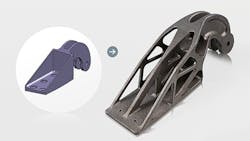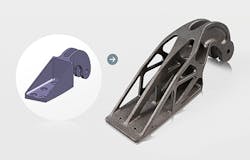3-D Printing: One Small Step for a Greener Airplane?
Is 3-D printing greener than conventional manufacturing? It’s one of the many questions about this disruptive technology that is being explored. While 3-D printing or additive manufacturing typically uses less material than other processes to produce a part, the process itself can be energy intensive as it frequently involves melting a material at high temperature.
Just the manufacturing process used to produce a part doesn’t tell the whole sustainability story, however. Environmental assessments become more useful as they encompass the full lifecycle of a product, from obtaining the material to manufacturing to use and ultimately reuse or disposal.
Airbus Group Innovations and EOS, a 3-D printing company, recently conducted an environmental comparison between a conventional steel Airbus A320 nacelle hinge bracket and a titanium bracket produced using direct metal laser sintering (DMSL).
Airbus and EOS then compared production of a titanium bracket using both rapid investment casting and additive manufacturing. They found that the additive manufacturing offered a slight advantage in energy consumption. However, the consumption of the raw material in 3-D printing was up to 75% less than with casting.
While EOS cautioned that it hadn’t looked yet at the issue of scalability, it said the test demonstrated the potential for reducing the weight of the plane by 10 kilograms – “a noteworthy figure in aviation where every kilo counts.” By optimizing the bracket design, it found, CO2 emissions were reduced by almost 40% during the lifecycle of the part.
“In general, the joint study revealed that DMLS has the potential to build light, sustainable parts with due regard for the company’s CO2 footprint,” said Jon Meyer, Airbus’ additive layer manufacturing research team leader.
About the Author
Steve Minter Blog
Executive Editor
Focus: Global Economy & International Trade
Email: [email protected]
Follow on Twitter: @SgMinterIW
Call: 216-931-9281
An award-winning editor, Executive Editor Steve Minter covers global economic and international trade issues, tackling subject matter ranging from manufacturing trends, public policy and regulations in developed and emerging markets to global regulation and currency exchange rates. As well, he supervises content production of all IW editorial products including the magazine, IndustryWeek.com, research and informationproducts, and executive conferences.
Before joining the IW staff, Steve was publisher and editorial director of Penton Media’s EHS Today, where he was instrumental in the development of the Champions of Safety and America’s Safest Companies recognition programs.
Steve received his B.A. in English from Oberlin College. He is married and has two children.

